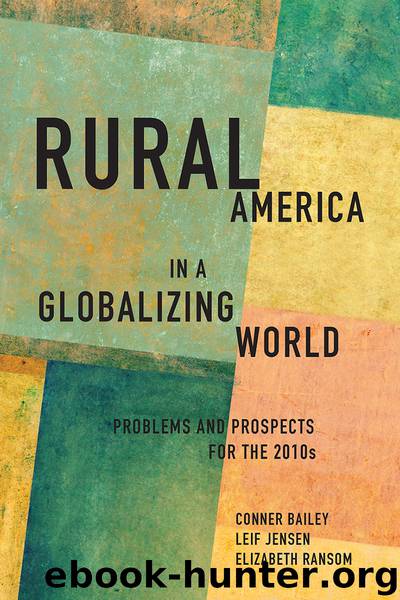Rural America in a Globalizing World: Problems and Prospects for the 2010s by Conner Bailey Leif Jensen & Elizabeth Ransom

Author:Conner Bailey, Leif Jensen & Elizabeth Ransom
Language: eng
Format: epub
ISBN: 978-1-940425-12-2
Publisher: West Virginia University Press
Published: 2014-09-22T16:00:00+00:00
Chapter 18
* * *
Rural Families and Households and the Decline of Traditional Structure
JESSICA A. CARSON AND MARYBETH J. MATTINGLY
Introduction
Traditional images of rural America center on communities in idealized agrarian landscapes, bound by shared ethics and strong kinship ties (MacTavish and Salamon 2003; Tarmann 2003). Traditional family structure is also part of this image, and for decades rural families were indeed larger, more stable, and less diverse than their urban counterparts (e.g., Johnson 2006; Snyder 2011). However, toward the end of the twentieth century, in the face of dramatic economic and social changes, the characteristics of rural and urban families started to become more similar, a convergence that continued into the 2000s.
This confluence is due in part to major changes in the composition of families nationwide. For example, over the past several decades, there have been steep rises in cohabitation and non-marital births (Bumpass and Lu 2000), increasing age at first marriage, and high rates of martial dissolution (Smock and Greenland 2010). In more recent years, research shows an increase in “doubled up” households, particularly since the onset of the Great Recession (Seltzer, Lau, and Bianchi 2012). In an age of residential mobility, technology-aided communication, and changing family culture, contemporary rural families are less isolated than their historical counterparts, and are more similar to families residing in suburban and urban places.
We explore how some of these social and demographic changes have played out for rural families over the first decade of the millennium. We measure these effects by focusing on three particular areas of rural households and families: (1) household composition, (2) household and family size, and (3) household demographics. Within each of these three areas, we first provide a portrait of rural families in 2010 that can be used as a benchmark as we proceed toward 2020. We then document the changes in rural households and families between 2000 and 2010, and compare these shifts with those occurring in suburban and urban places.1 In considering new rural household and family patterns, we situate rural life within the landscape of increasingly complex household formations, influenced by declining rates of marriage, increases in cohabitation, and increases in living alone.
Aside from the necessity of documenting family trends to provide demographers and policy makers with a current portrait of rural families, growing family heterogeneity can be accompanied by challenges to families and communities. With increased diversity may come increased inequality between households, particularly in families with a single earner (McLanahan and Casper 1995). In addition, household instability may impede families’ ability to meet long-term needs, such as raising children and caring for the elderly (MacTavish and Salamon 2003). Increasingly diverse families can translate to communities that are progressive and inclusive, promoting the well-being of all residents. While authors in subsequent chapters in this volume focus more explicitly on rural inequality, children and youth, and the elderly, here we provide a thorough examination of family and household structure as a backdrop for considering those specific issues. Throughout this chapter, we rely upon nationally representative data collected through the 2000 Decennial Census and the 2005–2010 American Community Survey.
Download
This site does not store any files on its server. We only index and link to content provided by other sites. Please contact the content providers to delete copyright contents if any and email us, we'll remove relevant links or contents immediately.
| Africa | Americas |
| Arctic & Antarctica | Asia |
| Australia & Oceania | Europe |
| Middle East | Russia |
| United States | World |
| Ancient Civilizations | Military |
| Historical Study & Educational Resources |
In Cold Blood by Truman Capote(3309)
The Innovators: How a Group of Hackers, Geniuses, and Geeks Created the Digital Revolution by Walter Isaacson(2838)
Steve Jobs by Walter Isaacson(2833)
All the President's Men by Carl Bernstein & Bob Woodward(2327)
Lonely Planet New York City by Lonely Planet(2171)
And the Band Played On by Randy Shilts(2129)
The Room Where It Happened by John Bolton;(2103)
The Poisoner's Handbook by Deborah Blum(2091)
The Murder of Marilyn Monroe by Jay Margolis(2058)
The Innovators by Walter Isaacson(2055)
Lincoln by David Herbert Donald(1944)
A Colony in a Nation by Chris Hayes(1880)
Under the Banner of Heaven: A Story of Violent Faith by Jon Krakauer(1748)
Amelia Earhart by Doris L. Rich(1648)
The Unsettlers by Mark Sundeen(1645)
Birdmen by Lawrence Goldstone(1619)
Being George Washington by Beck Glenn(1614)
Dirt by Bill Buford(1611)
Zeitoun by Dave Eggers(1590)
